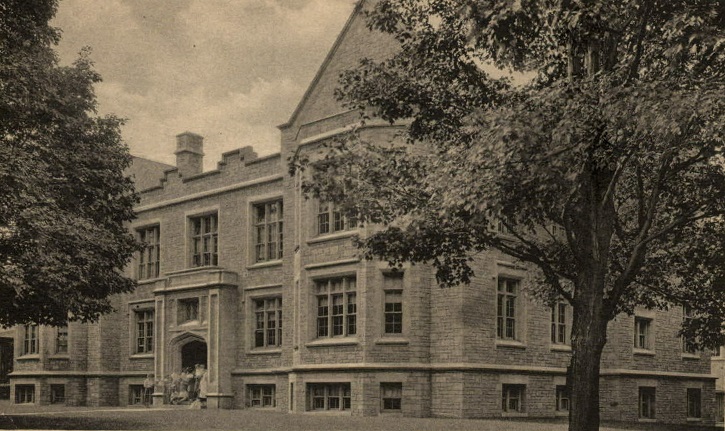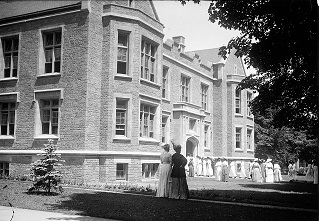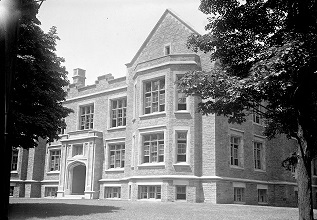
| Prince Street Campus | Catharine Strong
Hall |
 |
| Catharine Strong Hall from old postcard |
| Pictures of Catharine Strong Hall | |
 |
 |
The Catharine
Strong Hall was the gift of Henry
Alvah Strong in memory of his mother. It contained an
auditorium, classrooms, administrative offices, a small library, and a
lunchroom. Ground was broken in 1913 and the building was completed in
1914. The building was sold in 1956 and is still standing at 31
Prince Street.
References
1877 Catharine
Hopkins Strong (1809-1877), grave in Mt. Hope Cemetery
1914 "Play to Open Co-Ordinate College Buildings," Democrat and Chronicle, May 12, 1914, Page 17.
1914 "Make
First New of New Hall on College Campus," Democrat and Chronicle,
May 16, 1914, Page 18.
Many favorable comments in Strong and Anthony Halls.
1919 "Henry A. Strong, Long Business Associates of George Eastman, Dead in his Eighty-First Year," Democrat and Chronicle, July 27, 1919, page 38.
1919 Henry Alvah Strong (1838-1919), grave in Mt. Hope Cemetery
1927 Rochester,
the making of a university, by Jesse Leonard Rosenberger, with
an introduction by President Rush Rhees.
Page 293-295: Under the subheading of "A Co-ordinate College for
Women," President Rhees said, in his report to the trustees in June, 1912:
"It has become our growing conviction that it will be best for the
interests of men and women alike, if we can provide separate classes for
men and women in all prescribed studies. To make possible the realization
of this more adequate arrangement, the first essential will be an academic
building for women, in which recitations and lectures can be held. The
second essential will be the further increase of our productive funds by
an amount sufficient to make possible the addition of the teachers which
will be required for these separate classes."
The next year he recorded that two buildings were under construction on
the fine piece of land at the southwest corner of University Avenue and
Prince Street, diagonally opposite the campus, which splendid site for the
women’s buildings had been deeded to the university by Mrs. Aristine
Pixley Munn, mother of Dr. John P. Munn of the board of trustees of the
university. One of the two buildings was the Anthony Memorial Hall. The
other building was Catharine Strong Hall, a gift from Henry A. Strong, of
Rochester, to be a memorial to his mother, Catharine Hopkins Strong. Both
of the buildings, which were connected by a cloister, were completed in
1914, being constructed of blue limestone and after an attractive type of
Academic-Gothic architecture—and the Cathanne Strong Hall of fireproof
construction. Mr. Strong’s gift was made in the form of a subscription of
$100,000 toward the million-dollar fund, being the amount which it had
been agreed might be used for buildings and equipment. He was a son of
Alvah Strong who had been prominent among the founders of the university.
One of the announcements for the autumn of 1914 was that the completion of
Catharine Strong Hall and Anthony Memorial Hall had made possible the new
arrangements for separate instruction of men and women in all excepting
advanced elective subjects. The classes for women would be taught in
Catharine Strong Hall, with the exception of classes in laboratory science
which were scheduled for separate instruction in the several scientific
laboratories. The classes for men would be taught in Anderson Hall and the
several laboratories. Anthony Hall provided for the women students a
thoroughly modern gymnasium equipment, cafeteria lunchroom facilities, and
a suite of four rooms for social purposes. The popularity of these new
facilities, and of the policy of co-ordinate instruction, it was added,
appeared in an increased registration of women for the freshman class; and
it might possibly have had something to do with a larger registration of
men also.
1956 "University
School to Get New Hall," Democrat and Chronicle, January 3,
1956, Page 20.
Will move from Catharine Strong Hall to Taylor Hall.
1956 "Church
to Open College on Prince St. Campus," Democrat and Chronicle,
January 6, 1956, Page 33.
The American Jurisdiction of the Russian Orthodox Greek Catholic Church to
buy Catharine Strong Hall, Susan B. Anthony Hall, and Castle House.
1977 History
of the University of Rochester, by Arthur J. May (on-line
version with footnotes)
Chapter 17, Sunshine and Shadow
Physical equipment for the higher education of women in Rochester,
meanwhile, had passed through a revolutionary cycle. On land at the
southwest corner of University Avenue and Prince Street, formerly a
skating rink, and deeded to the University by Mrs Aristine Pixley Munn,
mother of Trustee Munn, two buildings for women exclusively were erected.
At the time, parenthetically, the donor was in her hundredth year.
In May of 1913 ground for the buildings was broken. Planned by architect
John Gade, the structures were so-called academic Gothic in style and
limestone from the Rochester region was used. Facing Prince Street,
Catharine Strong Hall, was given by Henry A. Strong, partner of George
Eastman, in tribute to his mother. It contained a commodious auditorium
with a stage, classrooms, a small library, administrative offices, and a
lunchroom. An enclosed passageway linked the Hall to Susan B. Anthony
Memorial Hall or Gymnasium, entered from University Avenue. Financed
partly by funds collected by admirers of the indefatigable suffragist
leader and more so from University resources, this structure had a
well-equipped area for physical training and rooms for social purposes.
Proposals for a swimming pool dried up because funds were not available.
Male students disdainfully referred to the women's complex as "co-edville"
and the connecting cloister as "The Chicken Run.
Speculations in the Rochester press that the University intended to
erect a dormitory for women on a plot to the west of the Presidential home
lacked factual foundation. Available for use with the opening of the
college in the autumn of 1914, the women's center released the "parlor" in
Anderson Hall for recitation rooms and study quarters for several
professors. In introductory courses, except for the sciences, women met
separately in Catharine Strong, though advanced courses were attended
jointly with the males. Where laboratory work was involved women and men
used the facilities at different periods.
© 2021 Morris A. Pierce